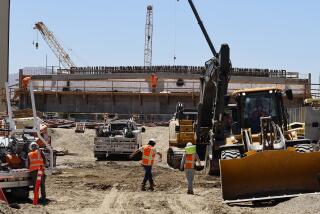Unemployment Rate Remains Stable at 5.2% : Economy: The figures for February ease recession fears. But manufacturing jobs are still dwindling, and gains in the service sector may increase inflationary pressures.
WASHINGTON — The nation’s unemployment rate remained unchanged at 5.2% in February, the Labor Department said Friday, while the return of laid off auto workers contributed to the addition of 372,000 jobs to the economy, the best new job performance since June, 1988.
Economists cautioned, however, that the surge in overall employment masked the fact that manufacturing jobs have fallen by 199,000 during the past 12 months as the goods-producing sector of the economy has steadily weakened.
Even so, analysts noted that the remarkable stability of the unemployment rate, which has remained within a narrow range of 5.2% to 5.3% for more than a year, indicates that the U.S. economy appears to be in no imminent danger of slipping into recession.
An alternate measure of unemployment that excludes members of the armed forces who live in the United States stood at 5.3% in February--the ninth consecutive month at that level.
Civilian unemployment in California, which had hovered just above 5% for several months, dropped to 4.9% in February. State figures tend to fluctuate more than the nationwide numbers because they are based on a smaller survey group.
The big increase in employment was attributable in part to recalls of 97,000 auto workers from January layoffs. Their return restored employment in that battered industry to its December level of 825,000--still 54,000 lower than in February, 1989.
Total job creation also was inflated by the unexpected addition of about 60,000 construction jobs as a result of unseasonably warm weather and the mass hiring of 20,000 Census workers to conduct the federal government’s decennial population count.
“The economy is not so strong as (those) 372,000 new jobs implies,” said Donald Straszheim, chief economist at Merrill Lynch & Co. in New York.
“The gain in autos is simply layoffs coming back, and not any new hiring,” he said. “We know there’s no strength in residential or commercial construction, so the 60,000 there is mostly weather. The continuing story here is that most of the new jobs are in the service sector, as they have been.”
Altogether, service industries contributed 221,000 new jobs last month, while manufacturing industries lost 7,000 jobs if the returning auto workers are not counted as “new” jobs.
Straszheim expressed concern that average hourly wage costs rose 0.5% in February, a relatively brisk rate that could contribute to inflationary pressures in the economy.
The wage growth reflected a tight job market in the health, retail and business services sectors as well as a 1.2% increase in manufacturing wages caused by the return of the highly paid auto workers.
Straszheim said the figures point to “an economy not about to fall into recession (with) little chance of a drop in inflation (and) little chance the Fed (Federal Reserve Board) will ease interest rates.”
Despite continuing pressure from the Bush Administration to allow interest rates to fall, the Federal Reserve Board has maintained a relatively tight grip on the nation’s credit supply in an effort to keep inflation in check.
President Bush’s chief economic adviser, Michael J. Boskin, said the increase in job creation “was well above the employment gains in the fourth quarter of 1989, and we believe the economy after a period of lower growth is likely to show progress” in 1990.
Economists disagree over whether a steadily growing services sector--which includes everything from doctors and lawyers to truck drivers, retail managers and store clerks--will lead to a lower or higher standard of living.
Irwin L. Kellner, chief economist for Manufacturers Hanover in New York, said the shift toward services reflects not only declining job opportunities in manufacturing “but the need of many, if not most, households to have two wage earners to make ends meet.”
“What is happening is that people are running harder and harder just to stay in place,” Kellner said.
More to Read
Inside the business of entertainment
The Wide Shot brings you news, analysis and insights on everything from streaming wars to production — and what it all means for the future.
You may occasionally receive promotional content from the Los Angeles Times.










